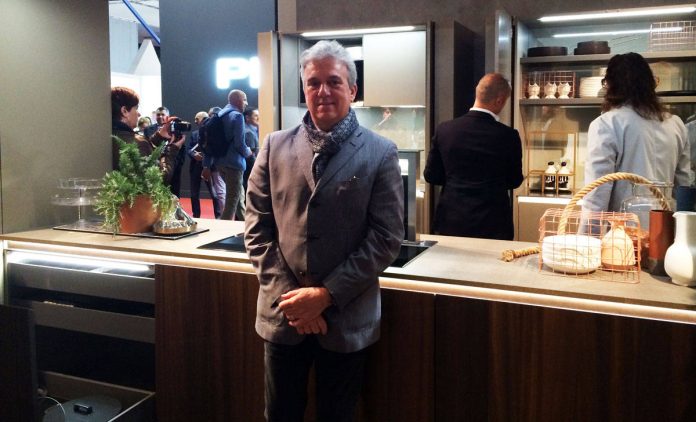Arte marks the start of your collaboration with Euromobil. How did the project develop?
Yes, this is the first project that I have created with the brand, but it is a company that I have known for some time, especially with regard to interior design. Having worked for some time on hospitality projects, where I was able to meet starred chefs and learn about the spaces intended for the installation of kitchens, I have always been attracted by this almost orchestral creative process, which begins with research, followed by the preparation of food and finally its presentation. So I wanted to take these ideas and bring them to the home environment on a smaller scale.
What is the stylistic hallmark of Arte?
We tried to ensure maximum efficiency of spaces and services. I started with an architectural idea: the kitchen is set up as a large portal that can be configured in countless different ways, flanked by two supports equipped with containers. The service elements, such as the “skylight”, the hob and the extractor fan appear and disappear on command. So the idea was to create a strictly formal kitchen, which is nonetheless fitted with highly efficient equipment that is available at all times, without being aesthetically intrusive.
What elements did you draw on from the professional kitchen?
Certainly the size of the hob and the basin, which are out of scale with traditional models, thus ensuring the efficiency of professional performance in a home environment. Moreover, the attention to materials, working on finishes that can be freely chosen by the end client and which help to give a sense of materiality and tactility to the surfaces; reflex glass that gives depth to the backdrop and metallic paint treated as artistic brushstrokes.
The kitchen derives its name from artistry – what does this refer to?
First of all, to the art of cooking; secondly, to the identity of a company that has always promoted contemporary art. Finally, to the artistic work created by the architect and by the company craftsmen who transform the material into a product.
What environments is this kitchen suitable for?
The aim was to create a product that could be added to small living spaces as well as large settings, in line with the company’s Total Living philosophy, a key means for overcoming the concept of the local kitchen. Arte primarily targets the residential sphere, focused on domesticity and aspects of food culture, which form the basis of the story and research. This is why we have added special devices with which to play with these aspects.
For example?
The Arte project is designed to be broken down into much smaller elements to form specialized containers: a small bar, a small wine bar, a showcase, a library; so it is highly versatile in its simplicity. Then we focused on technology centred on sharing and entertainment: for example, there is a camera that can capture the stages of preparation of the dishes and share them online.
Is the kitchen the heart of the house?
This is still the place for sharing, conversation and meeting with family and friends. And it becomes even more so by inserting these communication elements: a window that opens onto socializing and above all entertainment. If you don’t have fun in the kitchen, life becomes sad, then knowing how to cook well is another story (he laughs, Ed.).
It is the first kitchen system that you have designed – did you enjoy designing it?
Yes, it was a very positive experience. In the course of my career, I have designed complex projects in terms of product design, from home automation systems to furniture and so on. The kitchen brings together elements that are already complex in their own right. The challenge is to give a kitchen the right versatility and metamorphic ability to efficiently interpret and match with the spaces. But thanks to the company’s operational capability, I think we achieved a good result.







